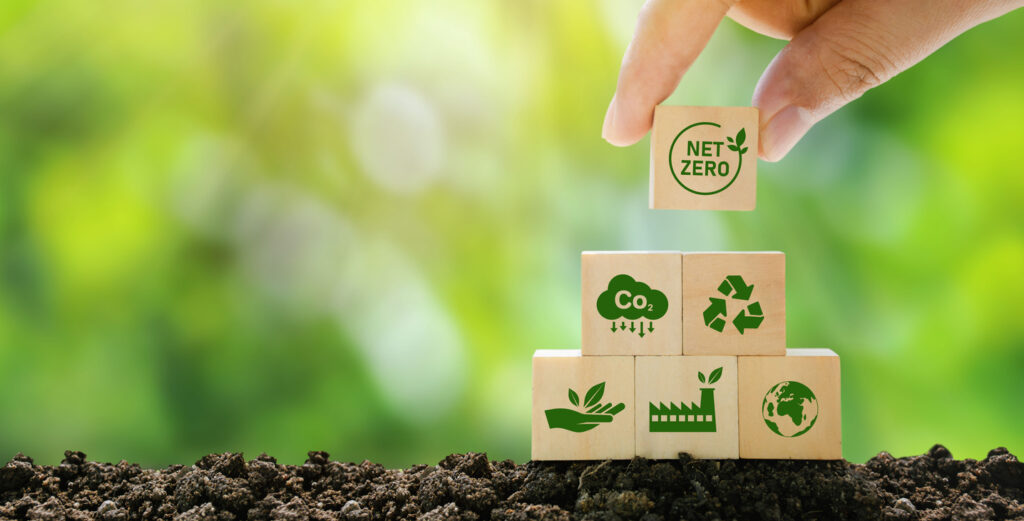The global population has doubled in the last 50 years; there are now over 8 billion people. To meet the demand for our resources, virgin material extraction has tripled in the same period – a staggering 100 billion tonnes of raw materials are removed annually.*
Forecasts predict that the earth’s inhabitants will reach 10 billion by 2050, ^ and therefore, the mining for the earth’s resources will reach 190 billion tonnes by 2060; almost doubling. * Needless to say, concerns have been raised about the future availability of supply.
Some studies have concluded that by then, we would need the equivalent of three planet Earths to provide the natural resources necessary to maintain current lifestyles. +
Society’s inefficient ‘take, make, dispose’ linear economy model has been highly unsustainable – for our environment, human health, our economy and also for the availability of vital resources for future generations.
The principles of the circular economy have provided a vital lifeline. With a shared commitment, we have the opportunity to transition to a regenerative ‘reduce, reuse, recycle’ model. Besides protecting our environment, it will provide all the resources we need for our economy to thrive.
When we consider the environmental impact of the linear model, our technology is a significant offender. By 2040, carbon emissions from the production, transportation and use of our tech devices will reach 14% of total global emissions ^^
Of course, you can’t have our rapid consumption of the latest tech, without disposal methods for the equipment we then consider obsolete. Unsustainably, the majority of e-waste still ends up in landfill or at hazardous informal processing sites overseas.
Waste electrical and electronic equipment (WEEE) is the world’s fastest-growing waste stream increasing by 3-5% annually. **
World Economic Forum.
Our digitalisation and connectivity drives our businesses and our society forward; undoubtedly helping us to respond to the global environmental challenges we collectively face. But a new sustainable vision of technology production and consumption is required to optimise resources and minimise consumption.
When it comes to a sustainable IT circular model, there is more to the approach than designing new modular products with repairability in mind or recycling redundant IT equipment. To decrease material extraction, we must achieve far more with less. We must maximise existing resources and their financial value, extend the lifespan of our products and then dispose of them responsibly when absolutely necessary.
However, in addition to the more obvious environmental benefits, circularity provides a substantial economic opportunity.

The economic value of e-waste
The economic potential of our devices or their components is central to the adoption of the circular IT model by both businesses and wider society.
Our e-waste holds significant residual value as the majority of the components can be recovered and re-enter the remanufacturing process. This more effective use of secondary resources maintains a higher residual value. Moreover, our devices contain many of the world’s precious metals and over 60 elements from the periodic table. ^^
There is 100 times more gold in a tonne of smartphones than in a tonne of gold ore.
PACE
In their 2019 paper, A New Circular Vision for Electronics, PACE reported that just one year’s global e-waste (then 50 million tonnes), would be worth a staggering $62.5 billion, (Over £47 billion). This is three times more than the annual output of the world’s silver mines and more than the GDP of most countries. ^^
The economic opportunity is significant in terms of asset recovery but in addition, circular ITAD solutions could also reduce costs for consumers. The PACE report suggests that this could be 7% by 2023 and 14% by 2040.

What are circular IT solutions?
Material recovery.
The circular approach is relatively simple, we should keep materials in use for as long as possible, ensuring they retain the highest commercial value, whilst decreasing virgin material extraction.
With financial gain the priority, it’s no secret that the mining processes to extract earth’s resources results in serious environmental and social consequences, creating vast quantities of waste rock, toxic by-products and often damaging human health. Harvesting the metal from our resources is more economically viable than virgin mining of ore; it is less energy intensive and creates far fewer greenhouse gas emissions.
Recycling technologies are continuously developing to extract secondary materials from reproduction. However, it is a complex process with strict standards and 16 different waste streams to prevent cross-contamination of toxic or banned substances. New technologies will soon be available to remove these pollutants, streamlining the process further.
The rapid growth of the Internet of Things drives the need for new components, the reuse of chips, sensors, drives and batteries will reduce over-consumption of the planet’s resources, extend the lifetime of the components and make devices more affordable for the end consumer. If the industry standardised components, this would drive the circular model further.

Use for longer.
Prolonging the lifespan of any product is more sustainable and extends its lifetime value. Through secure data erasure, upgrades and professional refurbishment, our IT devices can even compete with new products in terms of functionality, performance and even appearance. This in turn, increases the residual value of used devices IT asset disposition services. What’s more, by switching to a circular IT model, businesses can save up to 40% for a laptop of a very similar or even the same specification. ++
Businesses looking to upgrade their inventory can either choose to redeploy or circulate the refurbished assets between users or choose to sell redundant IT assets through trusted online resales platforms, recovering the higher-than-expected residual value. Improved transparency, extended warranties, traceability and clear device grading have increased reuse market efficiency. Coupled with the environmental and cost-saving benefits, this has left few reasons for organisations to maintain their linear approach to IT procurement and disposal.
The IT refurbishment market is set to grow by around 12% by 2025.
WISETEK
The Ellen Macarthur Foundation suggests that advancing cloud-based technologies may hold the key to asset longevity, proposing that today’s users are more attached to their data and flexibility, rather than their devices. Edge computing provides adaptability in computing power and memory; the hardware itself is simply a gateway. Its specification will become less important than its connectivity, reducing the need to upgrade, keeping devices in use longer and increasing the use of refurbished devices. The cloud, therefore, can play an important part in reducing e-waste.
With focus on functionality, devices remain in use for far longer and may have a second or even third life. Decreasing the cost of repairs or upgrades for businesses, professional circular ITAD refurbishers have a large pool of secondary resources ensuring they can supply large volumes of assets for organisations requiring delivery at scale.
IT asset disposition services will provide reassurance along with an ITAD chain of custody to prove that secure data wiping services have been undertaken. Addressing any data security issues concerns, an IT asset disposal accreditation certificate remains with the device as evidence that the GDPR data destruction requirements have been adhered to.

Dematerialisation.
One of the leading principles of the circular economy is the reduction of over-consumption and more efficient use. The Circularity Gap Report 2023 states that currently, the average EU citizen consumes 18kgs of electrical and electronic products, annually; compounded by the linear model and almost disposable consumption habits. *
Increasingly, organisations are investing and developing new ‘IT-as-a-Service’ models focused on the delivery of an ongoing lifecycle management service for devices, rather than a one-off sales transaction.
These cost-efficient service-orientated, subscription-based leasing models eliminate the upfront procurement costs for organisations. By optimising the asset over the course of its lifespan through repairs, upgrades, and refurbishment, the device value is maximised. Assets are kept in use for an extended period until the time comes for them to be responsibly recycled for secondary components.

By generating value from our redundant IT assets, we can transition towards circular economy solutions; seizing the economic opportunities presented, along with all the environmental benefits sustainable IT delivers.
Through the elimination of inefficient waste streams, material recovery, remanufacturing and by extending device lifespans, we can join in a shared vision to reduce over-consumption and the pressure on earth’s finite resources.
Moving away from the ‘take, make, dispose’ approach demands a shared commitment and societal behavioural change. To facilitate this, global governance and regulatory compliance is set to become more stringent.
Although the EU already leads the way when it comes to strict WEEE legislation, organisations that have already incorporated the circular model into their procurement strategy and IT asset disposal policy will remain ahead of the curve, having already implemented sustainable processes.
The circular economy model will not only help organisations achieve their sustainability goals, but it can be highly cost-efficient, providing substantial economic opportunities compared to the traditional linear model.
*Circle Economy; Circularity Gar Report, ^UN, +MAPFRE, **Tes-amm/World Economic Forum, ^^PACE, ++Wisetek,
Focused on circularity, tier1 Group deliver environmentally friendly ITAD services. With an in-depth knowledge of the secondary market, we ensure our clients capitalise on the economic opportunities of your end-of-life IT assets; returning the full residual value to you. By maximising the lifetime value of your devices, you increase your ROI whilst boosting your ESG rating to boot.
We make transitioning to a sustainable IT model as seamless as possible. We are soon to launch our ‘Device as a Service’, subscription-based leasing programme – helping businesses dematerialise their IT inventory for cost-effective, hassle-free lifecycle management.
To find out more about our secure data erasure services, device refurbishment or our new subscription service – contact our friendly teams on 0161 777 1000 (Manchester), 01621 484380 (Maldon) or visit www.tier1.com
Resources.
The Circularity Gap Report 2023 – Circle Economy, Circular Consumer Electronics – Ellen Macarthur Foundation. The Circular Economy and IT Assets – IDC (DELL Technologies), Refurbished Digital Devices. The Future of the Circular Economy – Wisetek, A New Circular Vision for Electronics – Time for a Global Reboot – PACE (Platform for Accelerating The Circular Economy) For World Economic Forum. MAPFRE, Tes-amm, World Economic Forum.



